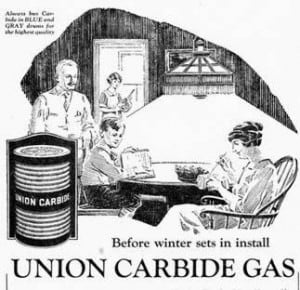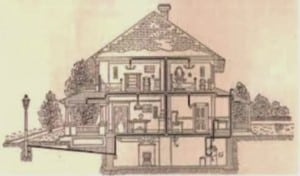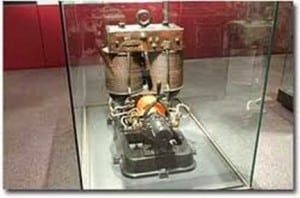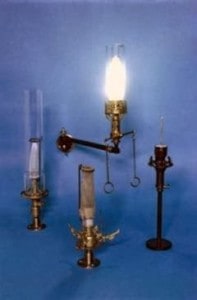Lighting at Rose Hill
By Alice Askins, Education Coordinator at Rose Hill Mansion
For some time I’ve been telling visitors that we did not know exactly when electricity came to Rose Hill. Recently, I found the answer to that question.
Geneva Advertiser, September 23, 1890
People who happened to cast their eyes across Seneca Lake last evening must have been a little surprised to see so much illumination about the Rob’t J. Swan mansion, now the home of E. H. PLUMMER. The occasion was the starting up of his new electric light, and… quite a number were invited over to inspect the house and the plant. About seventy responded, returning by carriages at a little after ten o’clock. …[Rose Hill] is elegantly furnished from bottom to top, with electric light in every room and about the grounds. He has a Dunning horizontal boiler, a Westinghouse engine and a dynamo of the United States Co., and the whole runs with less noise than a sewing machine.…
According to the newspaper, Mr. Plummer came from Detroit, and he intended to make Rose Hill a race horse breeding and training farm. He had plans to build a mile-long track (or at least a half-mile track) and spend the rest of his life at his new farm. Three years later, he had sold the place. Three years after that, Martin Smith of Geneva bought Rose Hill. On February 14, 1896, the Geneva Gazette reported that “M. H. Smith, Esq., has purchased the magnificent Rose Hill farm on the east shore of Seneca lake…. The mansion has 28 rooms, is heat [sic] by steam and lighted with gas generated on the premises.”
Our Curator John Marks informed me that the gas lighting in question was probably carbide or acetylene light. In 1892, the Canadian inventor Thomas Willson discovered an economical process for creating calcium carbide. This was an important step in the industrial revolution in chemistry, and it was made possible in the United States by the massive amounts of cheap power produced at and by Niagara Falls. Carbide was also useful for lighting. Water combined with calcium carbide released acetylene gas, and it became available for domestic lighting in 1894. The gas was piped through the house to fixtures where it burned. Though it was prone to gas leaks and explosions, it produced a very bright flame and was inexpensive. In fact, it was advised that you extinguish your cigar before refilling the system.
Carbide lighting was largely used in rural homes, though the Daily Advertiser said in January, 1896, that “Now is the time for cities desiring to operate their own gas plants to begin. Acetylene gas, the new illuminant, is 40 times more brilliant than that used ordinarily. People using it will therefore get much more light for less money. …Besides being so much more brilliant, acetylene gas does not flicker, which will make it still more desirable.”
I had to wonder, though, what happened to Mr. Plummer’s electrical system. There may be a hint in the paper. In 1893, Mr. Plummer tried to auction off all the stock and equipment at Rose Hill. The sheriff of Seneca County showed up and attached most of what Mr. Plummer was trying to sell. This suggests that Mr. Plummer was in financial straits and trying to sell things that other people claimed. The electrical system might have been repossessed, or eventually sold. It might also have been removed by the next owner of the property, Mr. H. S. Hopkins.
However the electrical system disappeared, there are reasons a homeowner might have preferred carbide. As my engineer brother Paul explained it to me, a steam powered dynamo running a generator would require more effort to turn on the lights, compared to the carbide generator:
Steam/Electric:
- Start a fire (probably coal.)
- Wait for steam. Monitor water level in boiler constantly so as not to have the house blown up. By the 1890s they would have had semi-automated boiler water level control, but not so automated that it would not have to be watched.
- Start the steam engine. Monitor throttle setting for proper voltage.
- Ongoing maintenance: boiler cleaning, fire box cleaning, ash removal, steam engine oiling and packing repair, steam pipe repair, light bulbs.
Carbide:
-
- Fill tank with water. Dump in enough carbide powder for a while.
- When lights dim, pour in more carbide.
- Ongoing maintenance: empty and refill the water tank, maybe replace the tank now and then, replace the lamp mantels, and occasionally repair gas pipes.
Carbide seems to have been the way to go. Now, at least, I can explain to visitors that electricity came temporarily to Rose Hill in 1890—but after that, mysteries remain.






My grandparents in Louisiana built a farmhouse in 1915 and used carbide lights. The “plant” set up on stilts and piped the gas around the house. I still have some of the pipes (small brass pipes) and one fixture without the glass globe.